What is RG174 Coaxial Cable? Specs, Loss & Applications
Sep 01,2025
Introduction
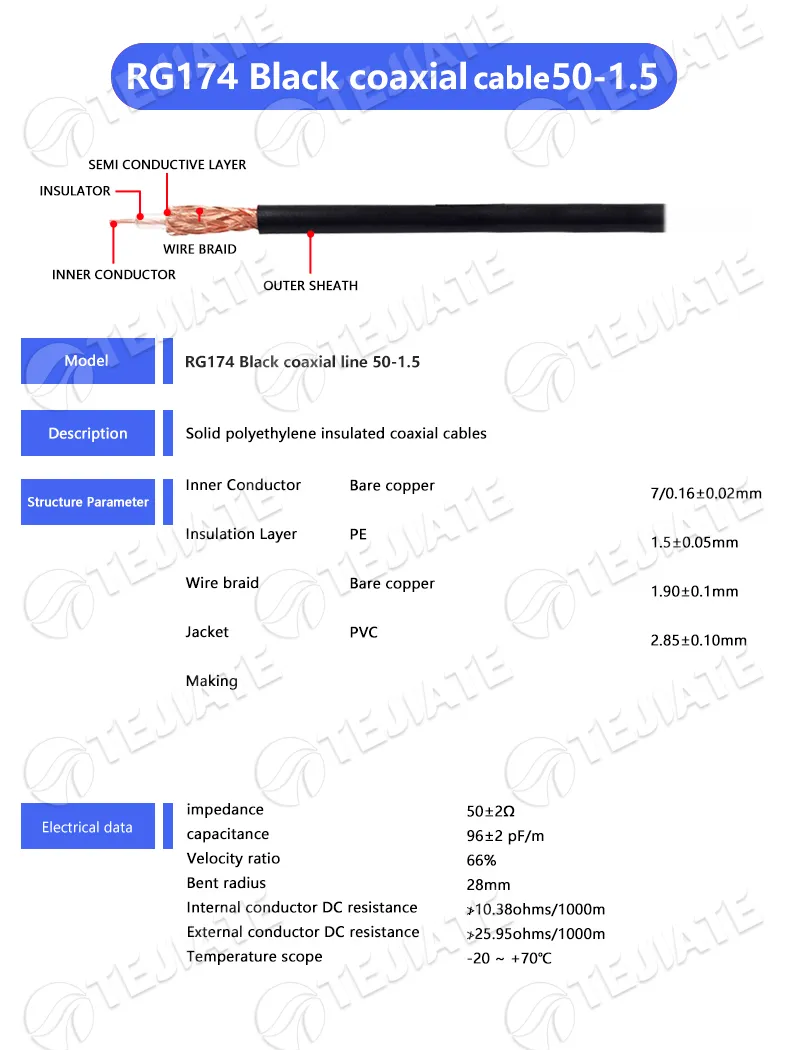
This image provides a foundational visual for understanding the RG174 cable's build. It clearly depicts the layered structure that defines its electrical characteristics: a central conductor (often 7/0.16mm bare copper), a solid polyethylene (PE) dielectric insulator, a braided shield for EMI protection, and a durable black PVC outer jacket. This construction is key to its flexibility and use in short-range RF applications.
When it comes to RF (radio frequency) systems, RG174 coaxial cable is a staple for short-range, flexible connections. You’ll often find it in IoT devices, wireless communication, and test equipment. Though it might seem like a basic cable, RG174 plays a crucial role in high-performance setups.
Whether you’re working in a lab, setting up a router, or designing compact antennas, RG174 can meet your needs. But like any other cable, it’s essential to understand its structure, performance, and best use cases before using it. In this guide, we will take a deep dive into RG174’s structure, applications, and performance characteristics, helping you determine when and where it’s the best choice for your projects.
What is RG174 Coaxial Cable?
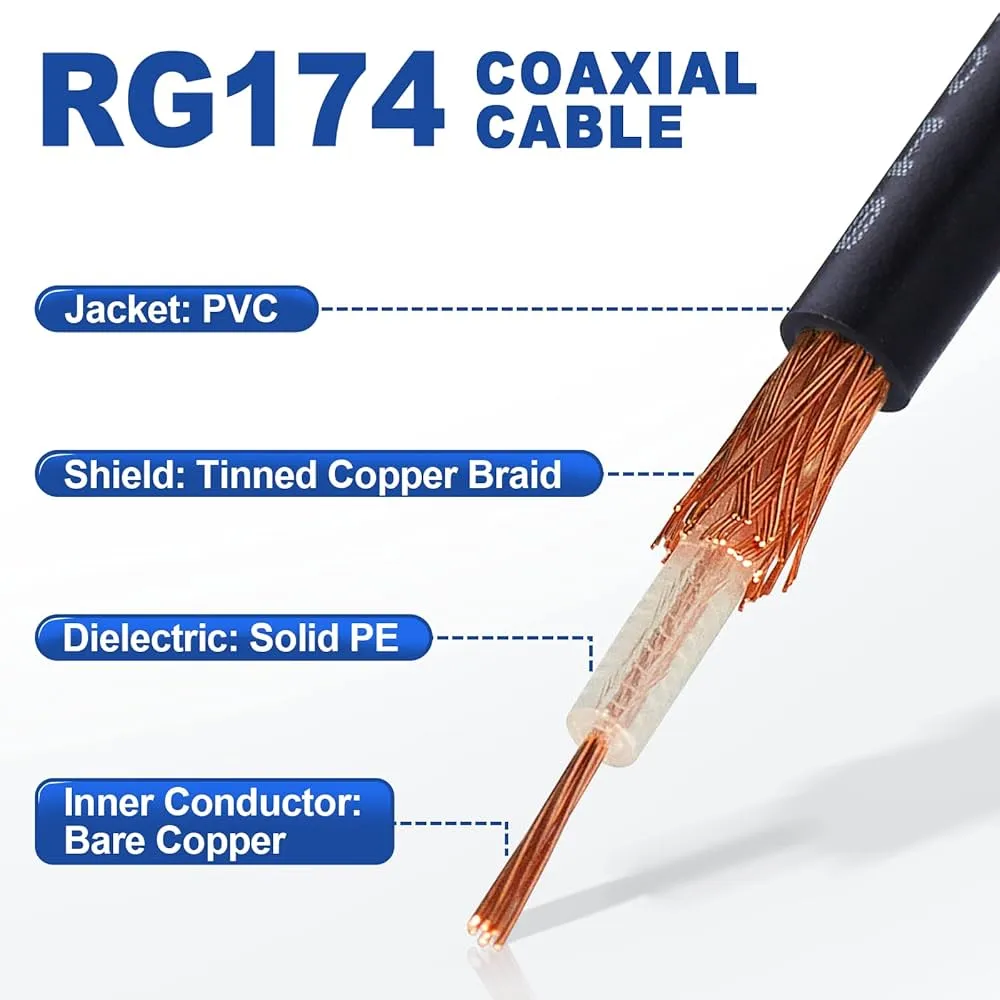
This diagram offers a clear, educational breakdown of the RG174 cable's composition. It visually separates and labels each critical layer, explaining the function of the PVC jacket (environmental protection), the braided shield (EMI/RFI suppression), the PE dielectric (insulation and signal integrity), and the bare copper inner conductor (signal transmission). This complements the textual description of its simple yet effective
Understanding RG174
At its core, RG174 is a 50-ohm coaxial cable designed for short-range connections. Its flexibility and compact size make it ideal for applications that require minimal space and flexibility. RG174 is often used for connecting devices in low-power RF systems.
This type of cable has a simple structure, consisting of an inner conductor, dielectric, braid shield, and jacket. The inner conductor is typically made of bare copper to ensure high conductivity, while the dielectric (typically PE) insulates the inner conductor, reducing the risk of signal interference. The braid shield, made from bare copper or tinned copper, protects against electromagnetic interference (EMI), while the PVC jacket provides physical protection against environmental damage.
With its low loss and high flexibility, RG174 is perfect for short runs where space and bending are concerns. It’s ideal for antenna connections, test leads, and cables inside equipment like radios, GPS units, and even cameras.
RG174 vs RG316: Key Differences
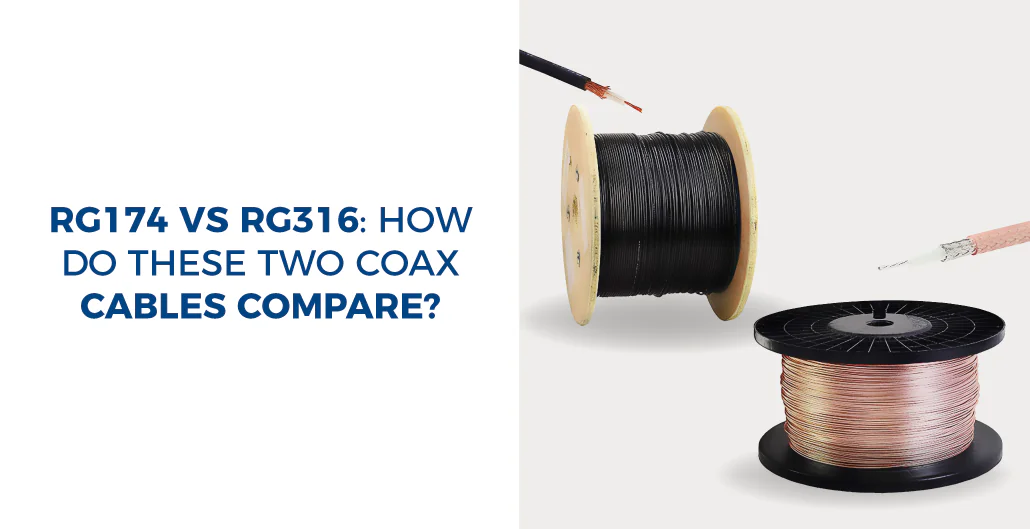
This image serves as a direct visual aid for the key comparison section between RG174 and RG316. It likely shows the two cables side-by-side, perhaps with callouts pointing out the different materials used in their construction (PVC vs. FEP jacket, PE vs. PTFE dielectric). This reinforces the textual explanation that while both are thin 50-ohm cables, RG316 is built for higher temperature stability and generally lower loss, whereas RG174 is a cost-effective solution for less demanding environments.
Comparing RG174 and RG316
Both are 50-ohm miniature coax, but they’re built for different constraints. RG174 uses a PE dielectric and a PVC jacket—light, very flexible, and cost-effective for short internal runs. RG316 uses PTFE with FEP jacketing—much better high-temperature stability and generally lower loss for the same length. In practice: pick RG174 for short, tight bends inside devices; pick RG316 when heat, stability, or tighter loss budgets matter.
Highlights
- Dielectric & Heat: RG174 = PE; RG316 = PTFE (rated for much higher temperatures).
- Attenuation: Loss rises with frequency on both; RG316 is typically lower-loss than RG174 for the same run length.
- Use Cases: RG174 for short internal pigtails, antenna leads, test jumpers; RG316 for aerospace/automotive/military or any high-temp environment.
Key Differences in Specifications
| Feature | RG174 | RG316 |
|---|---|---|
| Impedance | 50 Ω | 50 Ω |
| Dielectric | PE (Polyethylene) | PTFE (Polytetrafluoroethylene) |
| Temperature Range (typ.) | -20 °C to +70 °C (PVC builds) | -55 °C to +200 °C |
| Loss @ 1 GHz (20 °C) | 105–125 dB / 100 m | 95–125 dB / 100 m |
| Applications | Short-range, flexible, internal wiring | High-temperature, lab/aerospace, critical systems |
| Power Handling (continuous) | Frequency/VSWR dependent; do not quote a single kW figure | Frequency/VSWR dependent; consult vendor curve |
RG174 Coaxial Cable Construction
Industry Typical Structure
Understanding how RG174 is built explains why it performs as it does in RF applications. A standard RG174 cable generally includes:
- Inner Conductor: Most commonly copper-clad steel (CCS, 7-strand), sometimes silver-plated. CCS gives strength but increases DC resistance compared with pure copper.
- Dielectric Insulation:Solid polyethylene (PE), providing ~66% velocity of propagation and stable capacitance (~101 pF/m).
- Shielding:Single braided tinned-copper shield with ~85–87% coverage; sufficient for many short-run RF uses but limited EMI suppression compared to denser braids.
- Outer Jacket:Black PVC sheath, ~2.8 mm overall diameter, giving mechanical protection and flexibility.
TEJTE RG174 (Black 50-1.5) Structure
TEJTE’s enhanced RG174 is designed for lower loss and stronger shielding than standard versions:
- Inner Conductor:Bare copper, reducing DC resistance and providing higher conductivity than typical CCS, ensuring lower insertion loss.
- Dielectric Insulation:Polyethylene (PE) with tuned capacitance (96 ± 2 pF/m), maintaining consistent impedance and minimizing leakage.
- Shielding:Bare copper braid with dense weave (≥640 strands), delivering superior EMI protection and a screening attenuation up to 90 dB, far beyond the ~40 dB typical rating.
- Outer Jacket:Black PVC jacket with “RG174” marking for easy identification, combining durability, flexibility, and quality control traceability.
Why TEJTE Performs Better
- Lower conductor resistance (bare copper vs CCS) → less signal loss.
- Stronger shielding (dense copper braid) → higher EMI immunity, stable signals in noisy environments.
- Quality assurance (clear jacket marking, controlled materials) → consistency across production batches.
Performance Characteristics of RG174 Coaxial Cable
Attenuation and Loss
Industry Typical Attenuation @ 20 °C(dB/100 m)
| Frequency (MHz) | Attenuation (dB/100 m) |
|---|---|
| 100 | ~32 |
| 400 | ~70 |
| 900 | ~105 |
| 1500 | ~150 |
| 1800 | ~165 |
| 2500 | >190 |
| 3000 | >210 |
TEJTE RG174 (Black 50-1.5) Attenuation @ 20 °C(dB/100 m)
| Frequency (MHz) | Attenuation (dB/100 m) |
|---|---|
| 100 | 13.05 |
| 400 | 30.16 |
| 900 | 68.22 |
| 1500 | 109.6 |
| 1800 | 120.8 |
| 2500 | 147.4 |
| 3000 | 166.8 |
Compared to industry values, TEJTE RG174 delivers significantly lower loss across the full band. For example:
- At 100 MHz: ~13 dB vs industry ~32 dB.
- At 1.5 GHz: ~110 dB vs industry ~150 dB.
This ensures better efficiency, longer usable runs, and improved high-frequency performance while retaining the slim 2.8 mm form factor.
Power Handling and Temperature Range
Industry Typical Values
- Continuous Power @ 1 GHz: ≈ 17–40 W (depends on supplier and installation).
- Peak Power: rarely specified, varies with frequency and VSWR.
- Temperature Range: from −25 °C up to +85 °C (PVC jacket).
TEJTE RG174 (Black 50-1.5) Values
- Peak Power Handling:2.1 kW (brand-rated), offering much higher margin than standard datasheets.
- Continuous Power: engineered to deliver safer operation under identical frequency and load conditions.
- Temperature Range: −20 °C to +70 °C, suitable for most indoor and electronics use cases.
Why TEJTE Performs Better
- Lower attenuation: up to 50% less loss than industry-standard RG174.
- Higher power margin: brand-rated at 2.1 kW peak.
- Stable quality: controlled materials (bare copper conductor, dense braid, tuned capacitance) ensure consistent electrical performance.
RG174 Coaxial Cable Performance Comparison
| Parameter | Industry Typical RG174 | TEJTE RG174 (Black 50-1.5) |
|---|---|---|
| Attenuation @ 100 MHz | ≈32 dB/100 m | 13.05 dB/100 m |
| Attenuation @ 400 MHz | ~70 dB/100 m | 30.16 dB/100 m |
| Attenuation @ 900 MHz | ≈105 dB/100 m | 68.22 dB/100 m |
| Attenuation @ 1.5 GHz | 150 dB/100 m | 109.6 dB/100 m |
| Attenuation @ 3.0 GHz | >210 dB/100 m | 166.8 dB/100 m |
| Continuous Power @ 1 GHz | 17–40 W (typical) | Higher margin, safer under same load |
| Peak Power Handling | Not usually specified | 2.1 kW (brand-rated) |
| Temperature Range | -25 °C ~ +85 °C | -20 °C ~ +70 °C |
| Cable OD | ~2.8 mm | ~2.8 mm (same form factor) |
Common Applications of RG174 Coaxial Cable
Industry Typical Applications
RG174 is widely used in short-range RF systems due to its small size and flexibility. Typical use cases include:
- Antenna Pigtails: Connecting GPS, Wi-Fi, or small radio antennas to receivers or modules.
- Test Leads: Flexible patch cables for lab setups, measurement instruments, or field diagnostics.
- IoT Devices: Short internal runs inside smart sensors, controllers, or wireless modules.
- Automotive Electronics: GPS units, dash cameras, and telematics modules, where cable routing space is tight.
TEJTE Optimized Applications
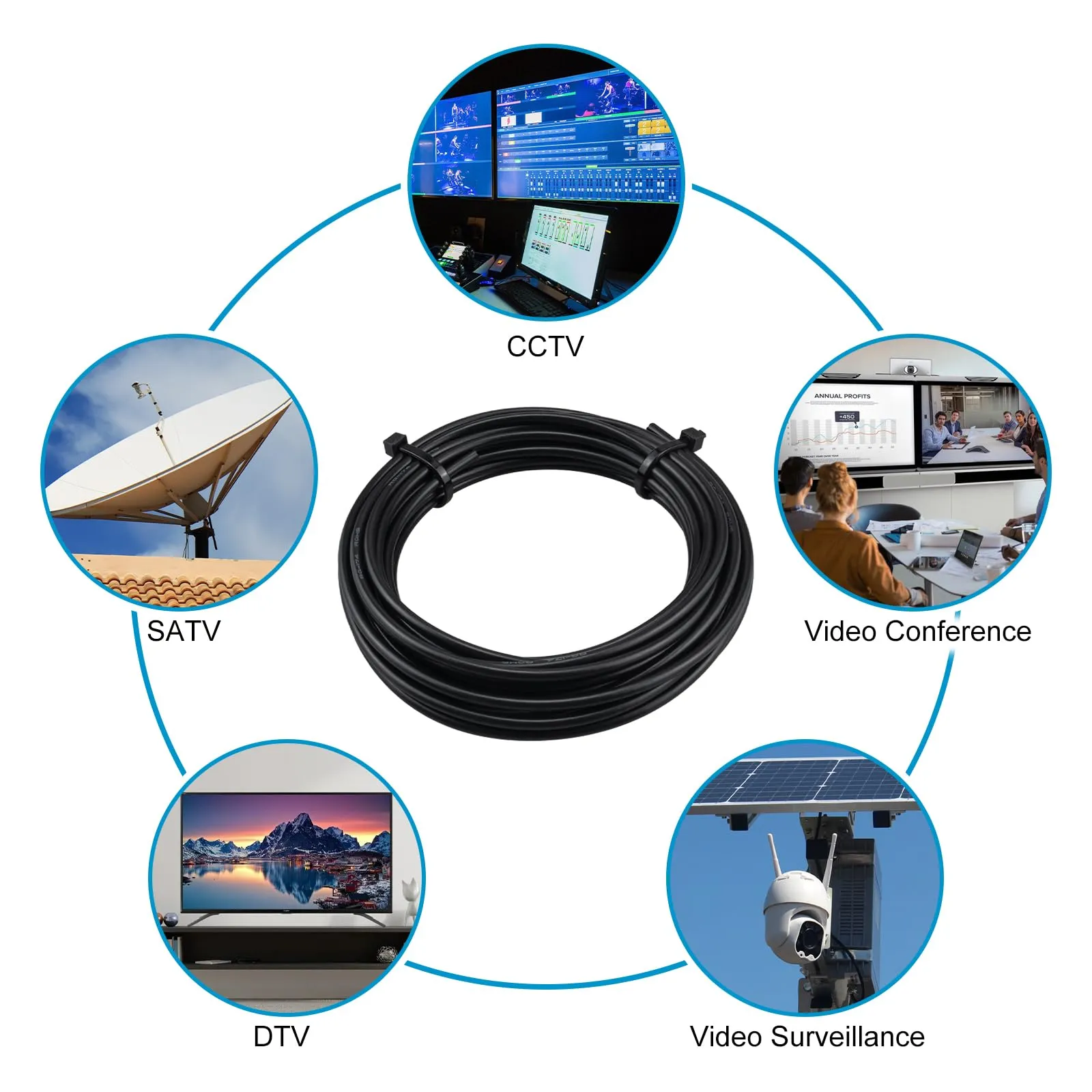
This image illustrates the typical use cases for standard RG174 cable mentioned in the text, specifically in the realm of video signals. It likely shows examples like a CCTV camera connected with a thin coaxial cable, a satellite TV setup, or video conferencing hardware. This highlights RG174's role beyond pure RF, extending into composite video or digital video signal transmission where its flexibility and small size are beneficial for internal wiring and short patches.
TEJTE’s RG174 (Black 50-1.5) offers lower attenuation and higher shielding, extending its usefulness beyond typical expectations:
- High-Frequency Modules: Thanks to reduced loss (e.g., only ~13 dB @100 MHz and ~110 dB @1.5 GHz), TEJTE RG174 supports more stable transmission in GHz-level systems.
- Noise-Sensitive Environments: With 90 dB screening attenuation, it performs reliably even in EMI-heavy conditions such as industrial machinery or crowded RF environments.
- Custom Assemblies: Supplied in 500 m rolls with clear jacket markings, our RG174 is ideal for OEMs building consistent, traceable cable harnesses.
- Enhanced Automotive/IoT Integration: Better shielding and lower resistance improve GPS and wireless connectivity inside cars, drones, and smart home devices.
Why TEJTE Makes the Difference
- More reliable signal in environments where standard RG174 would show noticeable loss.
- Greater design flexibility, allowing customers to extend cable runs or operate at higher frequencies without switching to bulkier types.
- Cost-effective upgrade, since it retains the same 2.8 mm size and standard connector compatibility while delivering superior performance.
RG174 vs RG58 vs RG316: Which to Choose?
Industry Typical Comparison
| Feature | RG174 (Industry) | RG58 | RG316 |
|---|---|---|---|
| Impedance | 50 Ω | 50 Ω | 50 Ω |
| Outer Diameter | ~2.8 mm | ~5 mm | ~2.5 mm |
| Dielectric | PE | PE | PTFE |
| Temperature Range | -25 °C ~ +85 °C | -40 °C ~ +85 °C | -55 °C ~ +200 °C |
| Loss @ 1 GHz | ≈125 dB/100 m | ≈60 dB/100 m | ~95–125 dB/100 m |
| Durability | Moderate | High | Very High |
| Applications | Short-range, flexible | Medium-range, higher power | High-temperature, aerospace |
| Cost | Low | Moderate | High |
From this table:
- RG174 is the most flexible and compact but suffers higher attenuation.
- RG58 is bulkier but much better for medium-range runs and higher power.
- RG316 handles extreme temperatures and maintains stable performance but costs more.
TEJTE RG174 (Black 50-1.5) vs Industry
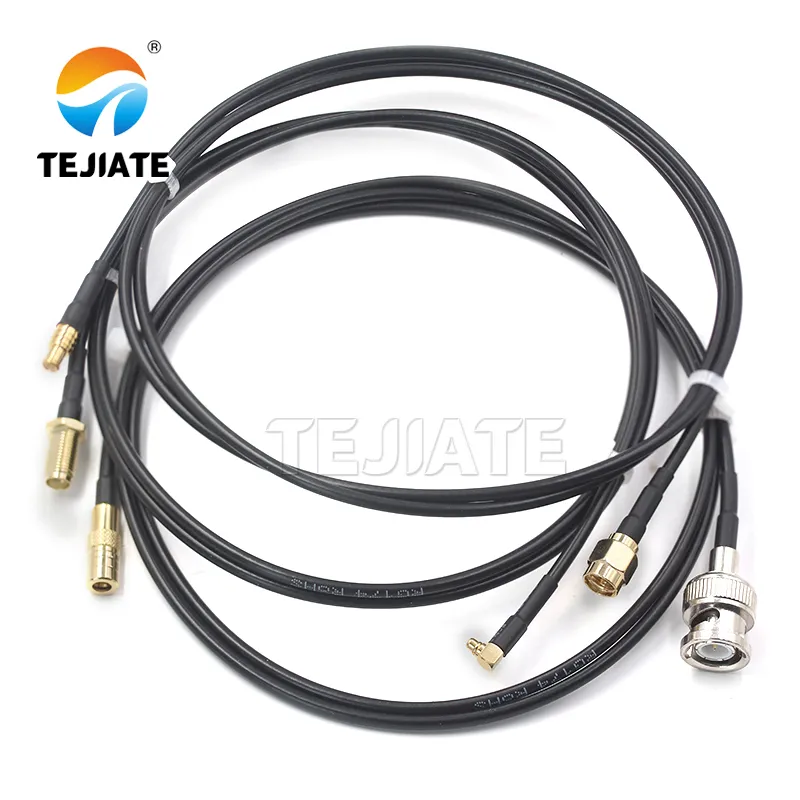
This infographic is dedicated to showcasing the enhanced performance characteristics of TEJTE's RG174 (Black 50-1.5) cable. It visually emphasizes the key selling points that differentiate it from standard RG174: dramatically lower attenuation across the frequency spectrum (exemplified by specific values like 13.05 dB/100m at 100 MHz and 109.6 dB/100m at 1.5 GHz, contrasting with higher industry standards) and its robust peak power handling capability (brand-rated at 2.1 kW). The graphic serves to quickly communicate the tangible performance benefits and engineering improvements of this specific product.
| Feature | Industry RG174 | TEJTE RG174 (50-1.5) |
|---|---|---|
| Loss @ 100 MHz | ≈32 dB/100 m | 13.05 dB/100 m |
| Loss @ 900 MHz | ≈105 dB/100 m | 68.22 dB/100 m |
| Loss @ 1.5 GHz | ≈150 dB/100 m | 109.6 dB/100 m |
| Shielding Effectiveness | ~40 dB | 90 dB |
| Peak Power | not specified | 2.1 kW (brand-rated) |
| Temperature Range | -25 °C ~ +85 °C | -20 °C ~ +70 °C |
With these improvements, TEJTE RG174 offers:
- Lower attenuation than industry-standard RG174, approaching RG316’s performance in short runs.
- Higher shielding (90 dB vs ~40 dB), making it more reliable in noisy EMI environments.
- Better power margin (2.1 kW peak), giving more safety headroom compared to typical datasheets.
Best Practices for Working with RG174
1. Measure Before Cutting
2. Avoid Overstretching
3. Use the Right Tools
4. Test Connections
5. Avoid Exposure to Extreme Conditions
Real-World Applications of RG174 Coaxial Cable
How RG174 Fits Into Everyday Technology
RG174 may seem like a simple cable, but it plays a critical role in a variety of real-world applications. Its compactness, flexibility, and low cost make it perfect for a range of industries and devices. Here are a few examples of where you’ll find RG174 in action:
Antenna Systems
RG174 is frequently used in antenna systems, where flexibility and size are crucial. Whether it’s connecting wireless routers, GPS antennas, or radio receivers, RG174’s ability to provide low-loss signal transmission in tight spaces makes it a top choice.
For instance, in GPS modules, RG174’s compact design ensures that it can connect the GPS receiver to the antenna, transmitting accurate location data over relatively short distances. In Wi-Fi routers, RG174 connects the antennas to the router’s main unit, allowing for flexible and reliable wireless connectivity.
Automotive Electronics
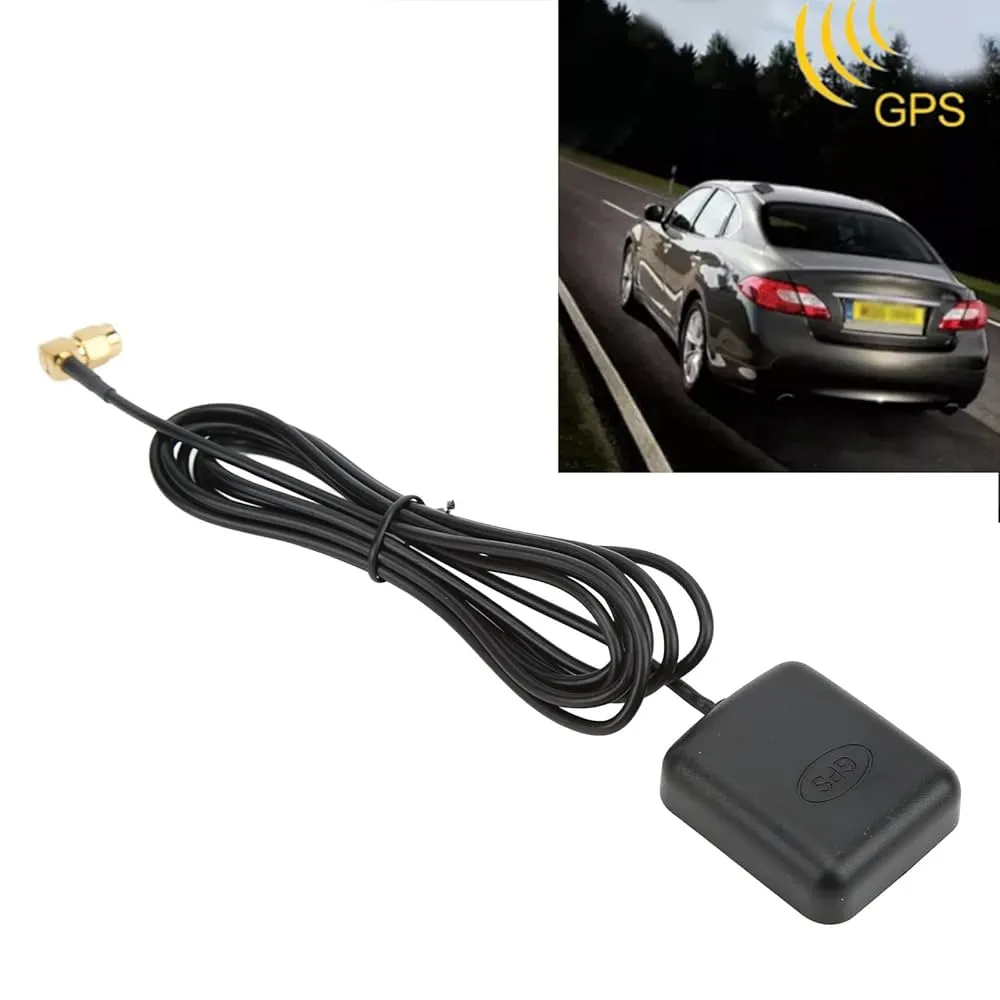
This image showcases the application of RG174 cable in the automotive industry. It likely depicts a scenario inside a vehicle, such as the area behind the dashboard or along the A-pillar. The thin RG174 cable is shown being routed through these tight spaces to connect a device like a GPS receiver module, a dash camera, or a satellite radio tuner to its antenna or power/data source. This emphasizes the cable's key advantages for automotive use: its small diameter and flexibility allow for easy installation in areas where larger cables would not fit, enabling connectivity for various in-car electronic systems.
Test Equipment
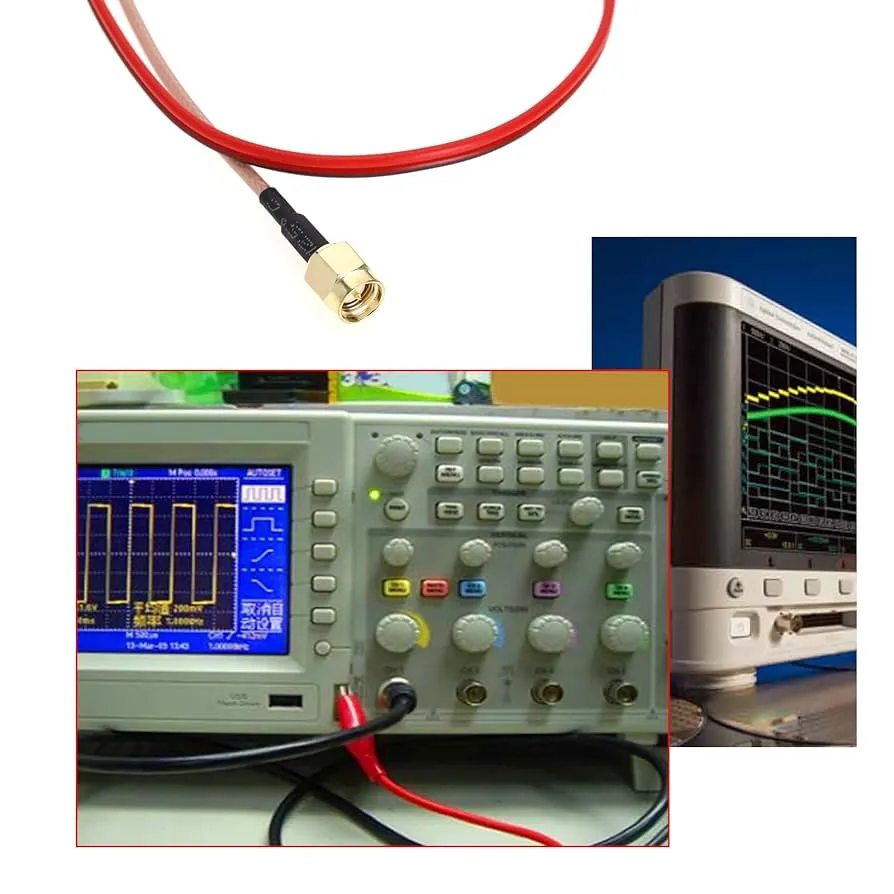
This image illustrates the role of RG174 cable in test and measurement applications. The setting is likely a laboratory workbench cluttered with electronic test equipment. One or more short RG174 cables, terminated with common RF connectors like BNC or SMA, are shown connecting pieces of equipment together (e.g., a signal generator's output to a spectrum analyzer's input). This highlights its suitability for this role: the flexibility allows for easy maneuvering on a crowded bench, and the short length keeps signal loss manageable for precise measurements, all at a low cost.
Wireless IoT Devices
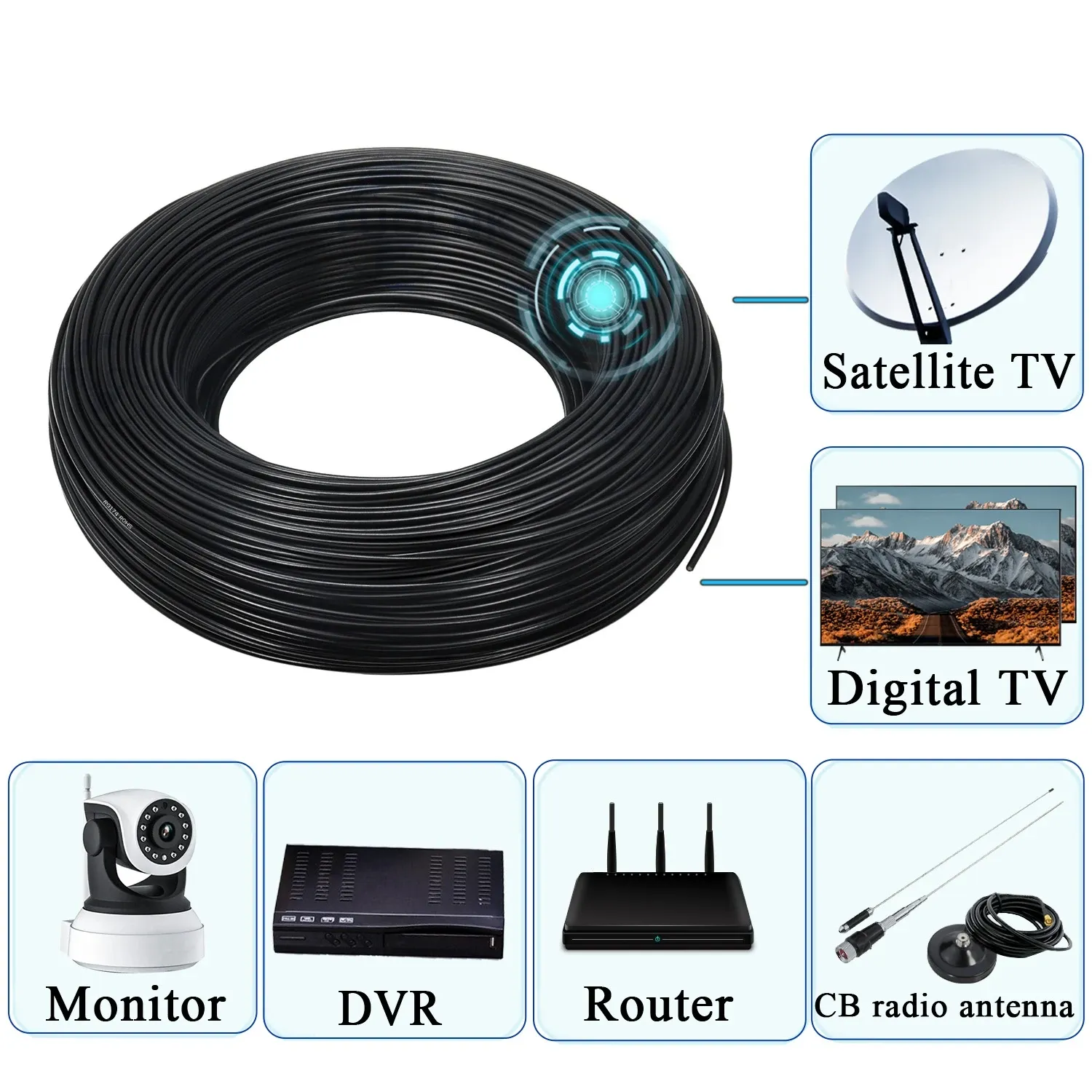
This image is a collage or representative shot showcasing the versatility of RG174 cable in consumer electronics and emerging IoT applications. It likely features multiple small scenes or products: the inside of a wireless router showing antenna connections, a satellite TV set-top box, a PCB of a smart home sensor (like a thermostat or security device) with a small coaxial connection, or other consumer devices like monitors or DVRs. The common theme is the use of thin, flexible RG174 for short-range RF or video signal transmission within the compact confines of these common devices, underscoring its widespread adoption.
RG174 Coaxial Cable vs RG58 vs RG316: Which to Choose?
Selecting the Right Cable for the Job
Understanding the differences between RG174, RG58, and RG316 is crucial when determining the best option for your project. While all three are 50-ohm coaxial cables, each has its own advantages, especially in terms of loss, flexibility, and durability.
| Feature | RG174 | RG58 | RG316 |
|---|---|---|---|
| Impedance | 50 Ω | 50 Ω | 50 Ω |
| Temperature Range | -20 °C to +70 °C | -40 °C to +85 °C | -55 °C to +200 °C |
| Loss at 1 GHz | 30 dB/100 m | 20 dB/100 m | 25 dB/100 m |
| Applications | Short-range, flexible | Medium-range, higher power | High-temperature, critical systems |
| Durability | Moderate | High | Very high |
| Cost | Low | Moderate | High |
Common Questions About RG174 Coaxial Cable
1. How to Crimp a BNC Connector on RG174?
Crimping a BNC connector onto RG174 requires careful stripping to avoid damaging the inner conductor. You’ll need:
- A coaxial stripper to cleanly expose jacket, braid, and dielectric.
- Slide the ferrule first, then insert the stripped cable into the BNC connector.
- Fold the braid back and crimp with a ratcheting crimp tool (≈3.25 mm die for RG174).
- Verify continuity with a multimeter or network analyzer.
TEJTE Advantage: With our bare copper conductor instead of CCS, the inner core crimps more securely and conducts better. The dense copper braid (≥640 strands) also locks firmly into connectors, improving long-term reliability.
2. What’s the Difference Between RG174 and RG316?
- Industry Typical:
- RG174: PE dielectric, ~125 dB/100 m loss @ 1 GHz, temp −25 °C to +85 °C.
- RG316: PTFE dielectric, lower loss, wide temp range −55 °C to +200 °C.
- TEJTE Advantage: Our RG174 achieves ≈110 dB loss @ 1.5 GHz with 90 dB shielding effectiveness, narrowing the gap with RG316 while keeping the same slim 2.8 mm size.
3. Will RG174 Work with RG179?
Both are 50-ohm miniature coax with similar diameters.
- RG174: PE dielectric, rated −25 °C to +85 °C.
- RG179: PTFE dielectric, rated −55 °C to +200 °C, better high-temp tolerance.
TEJTE Advantage: With lower attenuation (e.g., 13 dB @100 MHz, 109 dB @1.5 GHz), our RG174 delivers more efficient short-to-mid range runs than standard RG179, while staying cost-effective.
4. What’s the Thinnest 50-Ohm Coaxial Cable?
RG174 (~2.8 mm OD) is one of the thinnest mainstream 50-ohm coaxial cables. RG178 (~1.8 mm OD) is thinner but has much higher loss.
TEJTE RG174 strikes a better balance: thin and flexible like RG178, but with much lower attenuation, making it more practical for RF assemblies.
Best Practices for Working with RG174
- Measure Before Cutting: Always measure the required length of RG174 before making cuts. This ensures you avoid wasting cable and guarantees you have enough to complete your project.
- Don’t Overstretch: RG174 is flexible, but it should not be overstretched or bent beyond its rated minimum bend radius. Doing so could lead to signal degradation or cable damage.
- Use the Right Tools: For optimal performance, always use high-quality tools, including coaxial strippers and crimping tools designed specifically for RG174.
- Test Connections: After installing connectors, use a network analyzer or multimeter to verify the connection’s integrity. This ensures the cable works as expected, with no signal loss or interference.
- Avoid Exposure to Extreme Conditions: RG174 has a moderate temperature range. For extreme heat or cold, consider upgrading to RG316 or another cable rated for those conditions.
FAQ: RG174 Coaxial Cable
1. How to crimp a BNC connector on RG174?
To crimp a BNC connector onto RG174:
- Strip the jacket with a coaxial cable stripper (don’t nick the conductor).
- Slide the connector ferrule onto the cable.
- Insert the stripped end so that the center conductor fits into the BNC pin.
- Fold the braid over the ferrule and crimp using the correct die size.
- Test with a multimeter or analyzer.
With TEJTE RG174 (Black 50-1.5), the bare copper conductor ensures more reliable crimping compared to CCS-based cables.
2. Ham radio: which tool for stripping and crimping RG58 / RG174?
For ham operators or lab users:
- Stripping: use a coaxial stripper adjustable to small diameters (2.8 mm for RG174, 5 mm for RG58).
- Crimping: a ratcheting crimp tool with interchangeable dies for RG174 (e.g., hex 0.128″ or 3.25 mm) and RG58 (0.213″ or 5.4 mm).
- TEJTE recommends high-precision crimp dies to maximize contact reliability.
3. What is the difference between RG174 and RG316?
- Industry Typical: RG174 uses a PE dielectric, operates from −25 °C up to +85 °C, and has loss typically between 105 and 125 dB per 100 m at 1 GHz. RG316 uses PTFE dielectric, operates from −55 °C up to +200 °C, and has loss typically between 95 and 125 dB per 100 m at 1 GHz.
- TEJTE Advantage: Our RG174 (Black 50-1.5) achieves only about 110 dB per 100 m at 1.5 GHz, narrowing the performance gap with RG316 while keeping the same slim 2.8 mm size.
4. What’s the difference between RG174 and RG58?
- RG58: thicker (~5 mm OD), lower loss (about 60 dB per 100 m at 1 GHz), handles more power.
- RG174: thinner (~2.8 mm OD), more flexible, higher loss (about 125 dB per 100 m at 1 GHz).
- TEJTE RG174: optimized braid and bare copper conductor reduce loss compared to typical RG174, offering a balance between size and performance.
5. Is RG174 the thinnest and lightest 50-ohm transmission coax cable?
6. Will RG174 cable work with RG179?
- pF/m.
- RG179: PTFE dielectric, smaller diameter (~2.5 mm), higher temperature tolerance from −55 °C up to +200 °C.
Both are 50-ohm and similar in size, so they can use many of the same connectors.
TEJTE RG174’s lower attenuation makes it more efficient in short to mid-length runs compared to RG179.
Conclusion
RG174 coaxial cable is a reliable and cost-effective choice for many short-range RF applications. Whether you’re working with GPS systems, test equipment, or wireless IoT devices, RG174 provides an excellent balance of flexibility, size, and affordability.
Compared to industry-standard versions, TEJTE RG174 coaxial cable delivers lower attenuation, stronger shielding, and higher power margin, making it a stronger performer in compact and EMI-sensitive environments. While RG174 may not be the best option for long-range or very high-power applications, it excels where space is limited and signal loss must be minimized.
By understanding RG174’s specifications, applications, and best practices, you’ll be equipped to make the right choice for your project. For scenarios demanding even lower loss or higher durability, alternatives like RG58 or RG316 remain excellent options.
To learn more, check out our RG174 coaxial cables with verified specifications.
Bonfon Office Building, Longgang District, Shenzhen City, Guangdong Province, China

A China-based OEM/ODM RF communications supplier
Table of Contents
Owning your OEM/ODM/Private Label for Electronic Devices andComponents is now easier than ever.
